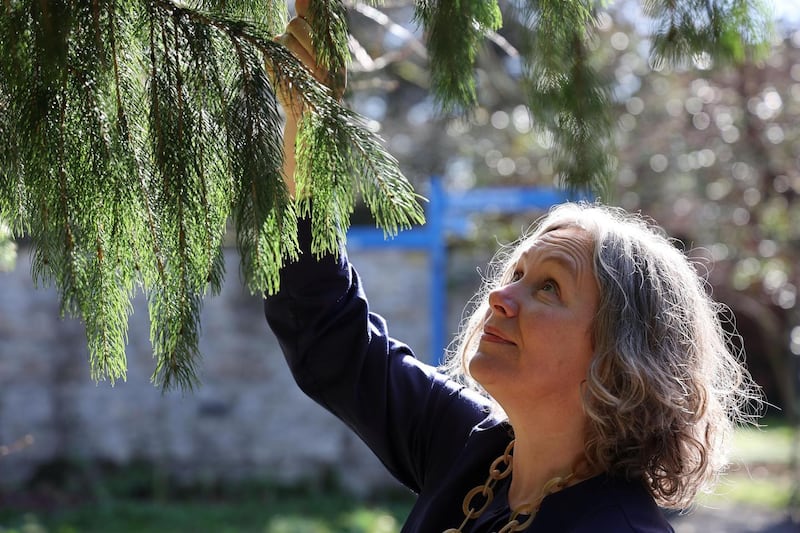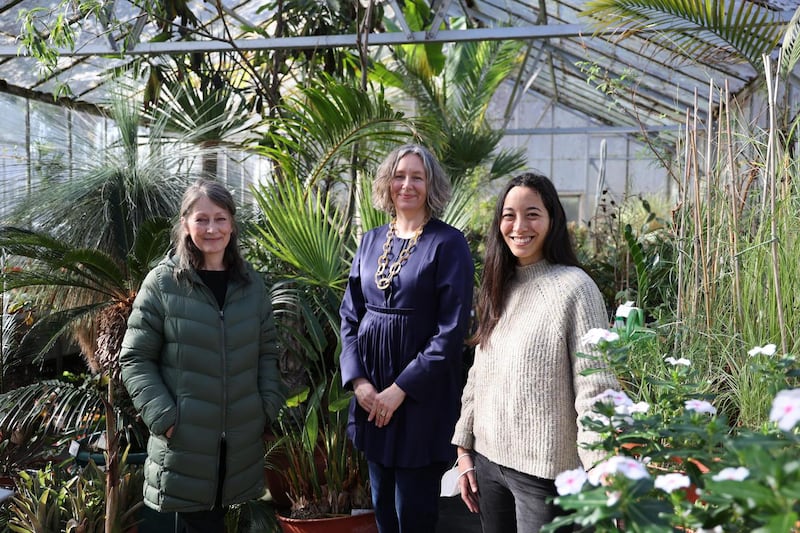Regular visitors to Palmerston Park in Dartry, Dublin will be fascinated to know that just at the edge of this popular city park lies a little known botanic garden run by Trinity College Dublin (TCD) since the 1960s. The low-key entrance behind a line of Scots Pine trees bordering Palmerston Park belies the treasures within numerous glasshouses and arboreta on this 1.5 hectare site.
Prof Jennifer McElwain, head of the Botany Department at TCD is the first female director of the Trinity Botanic Garden and regularly brings her students here to study plant diversity, evolution and propagation.
“The order beds [which split plants according to their lineage] allow us to teach plants groups based on their genetics or structural morphology,” she explains. And as the biodiversity van regularly brings specimens to laboratory classes to Trinity’s city centre campus.
But, our visit is to understand how botanic gardens around the world can help halt the biodiversity loss by storing and sharing seeds of rare plants and growing out others to test their resilience in changing climatic conditions.

As we move towards our first stop, the Cycad House, our attention is diverted to some echium [tall leafy plants which flower in the summer months] growing randomly on the path. Originally from the Canary Islands and loved by bees, they are technically an alien or invasive species which prompts a discussion on whether all alien species are bad.
"We are concerned about non-native plants which damage habitats or out-compete native species but we shouldn't get rid of others which enhance biodiversity. Species are dynamic and we can't just preserve everything as they are," says McElwain – summarising a debate on alien species that rages across academia. A case in point is the umbrella-shaped Alexander plant with tiny green flowers which escaped from monastic settlements and now commonly grows harmlessly in hedgerows throughout Ireland.
Once inside the tropical Cycad House, McElwain outlines how these palm-like plants are one of the most ancient plant groups. "One of the oldest we have is a 200 year old cycad from Mexico. They are an important way of teaching biodiversity so students can understand what current flora evolved from and how they adapt. This [whole] garden is a biodiversity hot spot."
As we wander through these glasshouses, some of which have seen better days, McElwain speaks about her ambition to upgrade them with research grade glass and make the gardens a zero-waste, zero-carbon test bed facility. “What I’d really like to do is to have solar greenhouses – there are very few of them in the world – where the geothermal electricity generated could be used to maintain the plants inside with temperature controls and computerised shading blinds and vents,” she adds.
At a time when Irish farmers have been asked to grow grain in response to potential shortages of wheat from <a class="search" href='javascript:window.parent.actionEventData({$contentId:"7.1213540", $action:"view", $target:"work"})' polopoly:contentid="7.1213540" polopoly:searchtag="tag_location">Ukraine</a> following the invasion of <a class="search" href='javascript:window.parent.actionEventData({$contentId:"7.1213540", $action:"view", $target:"work"})' polopoly:contentid="7.1213540" polopoly:searchtag="tag_location">Russia</a>, the importance of resilient crops for food supply has become a stark reality
Back outside, we wander through the arboretum next to Trinity Hall student accommodation. This is home to some rare tree species including Ginkgo Bilobas (one of the oldest living tree species), a handkerchief tree, a mulberry tree and a beautiful magnolia with its branches soaking up the heat from the brick wall it was planted next too.
McElwain’s plans here include studying a number of tree species to see how they are responding to particulate matter and carbon dioxide levels in the city. “We have a wide variety of trees here, both native and non-native, some of which are adapted to warmer Mediterranean conditions so if we can collect ten years of data, we will be able to recommend which trees are best to plant in the city. I think we need to have a wider diversity of street trees in Dublin based on their climate resistant,” she notes.
Midori Yajima, a Master's student from Rome has just arrived in Trinity to begin work on this tree study.
The gardens can also help conserve plant species that are at risk of extinction in other parts of the world. "Our long term plan is to have a database of all our species – the living collections and those in the cryo seedbank so that if we get a request from somewhere like Madagascar to provide seeds, we can do so. We currently have some living species here which are threatened with extinction on the Pitcairn Islands."
These specimens, which are threatened by clearance for tourism, agriculture and invasive non-native species, were collected by the curator of the Trinity Botanic Gardens, Dr Stephen Waldren and his team.
As part of their Trinity YouTube series in which five plants are explored in five minutes, McElwain plans to bring out four new episodes in 2022 on native Irish species threatened with extinction. "There are about 106 native flora threatened with extinction in Ireland and we want to collect seeds from each of these and conserve them. We have about 50 per cent of them currently since we established our seed bank in 1994," she says.

By way of example, she points out the Trinity seed bank has wild chives and wild asparagus seeds which no longer grow in Ireland. “It’s so important to have the crop wild relatives because they contain the genetic traits to withstand different environmental pressures that those that have been bred as commercial crops for higher yield.”
Michelle Murray, outreach officer at the Trinity Botanic Gardens adds that all botanic gardens are linked by agreement to the Botanic Gardens Conservation International. "We have exchange agreements to provide and get seeds and living plants from botanic gardens around the world," she adds.
At a time when Irish farmers have been asked to grow grain in response to potential shortages of wheat from Ukraine following the invasion of Russia, the importance of resilient crops for food supply has become a stark reality. The Trinity Botanic Garden has old malting barley, oats and rye in their seedbank which could be useful grains for Irish farmers to grow out.
The National Botanic Gardens in Glasnevin is running a project to protect cotton weed, a very rare silver-leafed plant with yellow button-like flowers which grows on coastal sandy soils in Wexford and has already become extinct in Britain. Horticulturists are growing it there as a protection policy if the last plants in the wild die out.
Back in the Trinity Botanic Garden, Mick McCann, the gardener who has worked here for 37 years says that one of its finest attributes [of the garden] is as a haven for wildlife. “I regularly see foxes, grey squirrels and hoverflies. Your attention can become microscopic if you sit in a quiet spot for a bit,” he says.
McElwain hopes to open the gardens to the public during the summer months of 2022 so the public can catch a glimpse of the tropical and native species looked after by full-time horticulturists, a curator and outreach officer in this suburban biodiversity hotspot.
History of Trinity Botanic Garden
One of the earliest established botanic gardens in the UK and Ireland and the only dedicated university botanic garden on the island of Ireland, the Trinity College Botanic Garden started as an on campus physic garden in the 17th century to provide plants material for the teaching of medicine.
After a period of neglect, it was expanded when the first lecturer in botany was installed in 1711. In the early 1800s, Trinity established its botanic gardens in Ballsbridge on leased land where a wide variety of species - including orchids, ferns, palms and cacti - were grown.
The gardens moved to their current location next to Trinity Hall in Dartry in the 1960s. Many important plant specimens were transferred including a 25 foot-tall Ginkgo biloba and various cycads. The garden's 10-year strategy (2020-2030) stresses its mission is "promote the importance and value of plants for future sustainable development through conservation, teaching, research, innovation and outreach".















